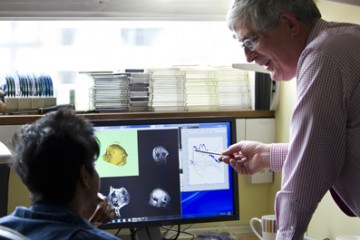Development of a new tissue-friendly head implant for use in awake, behaving monkey studies

At a glance
R
- Refinement
Contents
Overview
Project background
The understanding of both normal and disordered brain function relies on recording electrical signals generated by single neurons. These recordings are made in awake, behaving experimental animals performing movements similar to the human movements of interest. For example, the understanding of neural control of skilled hand movements and how these are disrupted by stroke or spinal injury is often studied in non-human primates. Stable recordings of individual cells require head restraint during the period of recording. Conventionally, this is achieved by surgically implanting an inert metal restraint device onto the animal’s skull.
Why we funded it
This Project Grant aims to develop a refined custom-fitted head-holding device for macaque monkeys using a non-invasive MRI-based approach.
The conventional restraint devices suffer persistent issues with infection and instability. The metal device is not tissue friendly and infected tissue can lead to tissue necrosis, requiring long periods of antibiotic treatment or euthanasia of the animal. Instability of the device impacts on data quality and can require further surgical intervention to stabilise the device or replace the device entirely.
Research methods
The restraint device to be developed in this project will be made from a bone-friendly synthetic that promotes natural bonding with bone regrowing from beneath the implant. This material is already used in human applications such as eye orbital reconstruction and is currently in development for the construction of artificial bone needed in brain surgery. Characteristics of the novel device will be evaluated throughout the study to compare against the conventional metal device ensuring its suitability and efficacy as well as comparing infection levels. The synthetic material is also compatible with magnetic resonance, whereas the metal implant is not, allowing non-invasive imaging to be carried out improving the yield of behavioural and neurophysiological data from each monkey.
Application abstract
An important approach to our understanding of both normal and disordered brain function is to make recordings from the tiny electrical signals that are generated by single neurons that make up the brain’s functional networks. In the brain’s motor network, analyzing the spike activity of single neurons is essential to our understanding of the neural control of skilled hand movements and its disruption by disorders such as stroke and spinal injury. When recordings are made from awake, behaving experimental animals performing such movements, stable recordings from single cells requires head restraint during the period of recording. Conventionally this is achieved by implantation of an inert metal restraint device onto the animal’s skull. There are disadvantages with this approach: first, such implants are not tissue friendly, and eventually infection leads to tissue necrosis and instability or breakage of the implant. Second, metal implants prevent the use of non-invasive MR imaging to identify the structures from which recordings are to be taken, or to image electrodes in situ.
We propose to trial a novel MRI-based approach that allows non-invasive 3D reconstruction of the skull and brain of macaque monkeys. This surface-rendered reconstruction is then used to guide fabrication of a custom-fitted head-holding device. This device is made out of a novel bone-friendly synthetic, non-toxic polymer containing crystals of calcium hydroxy-apatite (HAPEX ©). This compound promotes natural bonding, with bone regrowing from beneath the implant. It has two major advantages for long-term use in awake, behaving monkey studies: first it tissue-friendly which means that it would promote secure, stable and healthy implants that would improve the quality of the monkey’s well-being, reduce infection and avoid additional surgery when devices become loose or broken. Second, it is MR-compatible, and this means that further non-invasive imaging can be carried out, which allows better targeting of recording and stimulation procedures, which is all important in refinement of the experimental data obtained from small numbers of valuable and expensive animals. This development will help to improve the yield of behavioural and neurophysiological data from each monkey and thereby reduce the total number of monkeys required for each project. We propose to test the implants, using a number of different measures to check for implant stability, reduced infection and promotion of healthy bone re-growth after implant.
Impacts
- Resources: Chronic Implants Wiki
Publications
- Vigneswaran G et al. (2013). M1 Corticospinal Mirror Neurons and Their Role in Movement Suppression during Action Observation. Current biology 23(3):236-243. doi: 10.1016/j.cub.2012.12.006
- Vigneswaran G et al. (2011). Large Identified Pyramidal Cells in Macaque Motor and Premotor Cortex Exhibit “Thin Spikes”: Implications for Cell Type Classification The Journal of Neuroscience 31(40):14235-1424; doi: 10.1523/JNEUROSCI.3142-11.2011
- Krasov K et al. (2011). Ventral Premotor–Motor Cortex Interactions in the Macaque Monkey during Grasp: Response of Single Neurons to Intracortical Microstimulation The Journal of Neuroscience 31(24):8812-882. doi: 10.1523/JNEUROSCI.0525-11.2011
- Kraskov A et al. (2009). Corticospinal Neurons in Macaque Ventral Premotor Cortex with Mirror Properties: A Potential Mechanism for Action Suppression? Neuron 64(6):922-930. doi: 10.1016/j.neuron.2009.12.010
